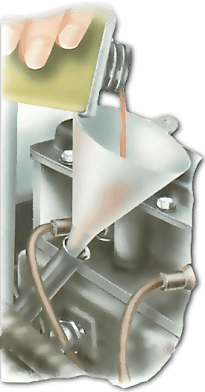
Why and How to Check Transmission Fluid Level?
Most car owners know that in order to keep their ride serviceable, they have to stay up-to-date on routine maintenance, such as tire replacement and oil change. But you should also consider your transmission. Keeping your transmission running smoothly can pay dividends, as it’s one of the most expensive components on your vehicle to repair or replace.
Luckily, checking transmission fluid level is neither as tricky, as time-consuming, nor as costly as you may think. Below are the most recommended ways by car repair experts on how to check transmission fluid level properly.
What is Transmission Fluid?
Transmission fluid keeps metal parts inside your gearbox from grinding down. It’ll also keep the different components of your transmission cool. Changing mechanical gears is a hard task for your vehicle. This fluid enables your car to shift with ease while guarding the metal parts that rub against each other from wearing down.
Types
- Automatic – Automatic transmission fluid or ATF is used in all cars that have automatic transmissions, likewise some more modern manual transmission cars. It’s optimized for the requirements of an automatic transmission and assists with functions such as gear lubrication, brake band friction, and valve operation.
- Manual – Manual transmission oil is never used in any automatic transmission cars. It can be a variety of different oils from normal motor oil to heavyweight gear oil. Always check the specifications for your car.
It’s important to be sure you know whether your car requires manual transmission fluid or automatic transmission fluid to keep vehicle running correctly.
Synthetic vs. Traditional Transmission Fluid
There’s no clear-cut consensus on whether traditional or synthetic transmission fluid is better. Different car manufacturers will have different specifications.
- Traditional fluid has been made by taking crude oil and reshaping the hydrocarbons to the specifications of different vehicles;
- Synthetic fluid is developed through a variety of chemical reactions, such as temperature and pressure, to create the ideal transmission oil for your car’s transmission. Synthetic transmission fluid is less likely to oxidize, break down or thin out in higher temperatures.
How to Check Transmission Oil?
Just like the car’s engine needs oil to lubricate the different parts and protect them against wear and corrosion, your transmission is also lubricated by a special fluid called transmission fluid. Maintaining the adequate transmission fluid level is crucial to keep transmission shifting properly and your vehicle humming smoothly.

Step 1
Check the owner’s manual. Do you have an automatic or manual transmission? Manual transmissions don’t usually have a dipstick. They’re factory filled. No top-up is needed. The oil only has to be changed in the event of repairs.
Step 2
Locate the transmission dipstick if your car uses an automatic transmission. The dipstick is usually red (white or yellow for the engine oil dipstick). The owner’s manual will aid you in finding the dipstick.
- On front-wheel drive vehicles, the dipstick is on the driver’s side, on one side of the transmission. If you don’t locate it, your owner’s manual will show you where to look for it;
- On rear-wheel-drive cars, the dipstick is usually on the passenger side of the engine compartment, near the back of the engine.
Step 3
Remove the stick, wipe it using a clean cloth, reinsert it, leave it in for five seconds, then pull back out and check. Add oil if necessary, and use the fluid recommended by the manufacturer.
Pour only a little at a time, checking the level with the dipstick each time. It’s easy to add fluid, but quite challenging to remove it if you fill too much.
If the gear needs more than a quart or is using oil regularly, take your vehicle to the car repair shop to have it checked for leaks.
Note – Transmission fluid level check requires working under the hood of a vehicle with the engine running. This can be quite dangerous if you aren’t careful. Watch out for moving parts, including fans, fan belts, pulleys, and so on. If you aren’t comfortable with this procedure, always take your car to repair service to have the transmission fluid checked.
When to Check Transmission Fluid?
You should check vehicle’s transmission fluid at regular intervals like you check your car’s oil. Even if your vehicle’s service manual says to check it every 100k miles, you should check it at least every month or every two months. Most drivers don’t feel the need to check their fluids regularly. They may also think the only purpose of transmission fluid is to lubricate internal components. But it actually does many other things that you’ll see in this article.
How to Check and Change the Automatic Transmission Fluid Level?
Many Fords, GMs, Toyotas, and other vehicles no longer have an automatic transmission dipstick for checking the fluid level. Carmakers are eliminating automatic transmission dipsticks. Newer gears are far more complex than older models, and the transmission oil levels are more critical. Special procedures are needed to check the fluid level in these vehicles.

- Disconnect the cooling line starting from the gear to the radiator. Connect rubber tubing to the pipe and put the free end of the tube in an empty container. Run the engine and allow it to idle. Transmission oil should flow out of the cooling line and into the container. Once the fluid stops flowing, turn off the motor and reconnect the cooling line to the radiator.
- Remove the bolts carrying the drain oil pan to the bottom of the transmission.
- Clean the drain pan using transmission oil.
- Replace the filter and the gasket.
- Once the gasket and the filter are in place, put the pan back on the gearbox. Tighten the bolts for the first few turns to avoid stripping the threads and use a torque wrench to finish tightening the bolts. Don’t overtighten the bolts, or you’ll damage the threads in the gearbox and dent the pan.
- Refer to the owner’s manual to use the appropriate automatic transmission fluid and fill it. Check the amount also.
Warning – You’ll have to access parts inside while the engine is on, remove plugs and attach tools on an engine and remove oil that is 190 F. Therefore, ensure all our body parts stay in the same condition and shape that they were before the service began. So, wear your safety glasses, burn sleeves, gloves, and restrain the car by suspension, blocking, or emergency brake.
Why Inspect the Automatic Transmission Fluid Level?
ATF is the sinew of the transmission. It produces the hydraulic pressure required to run the transmission. Plus, this fluid cools and lubricates the transmission. If the fluid level is low, the pump may draw air into the system. The air in the hydraulic system interrupts the proper fluid flow. Damage can happen rapidly when the transmission fluid is low.
How to Check Transmission Fluid Without Dipstick?
If the car doesn’t have a dipstick, the transmission fluid must be checked at the gearbox. It requires lifting the car on 4 jack stands – it must be on the even level (ground) to check the oil. There will be a fill plug on the side of the transmission case. This’s not the drain plug positioned at the bottom of the sump. With the transmission oil warm and your foot on the brake, shift the transmission through the gears so that fluid is in all of the internal passages. Then, with the engine idling, remove the fill plug. A small stream of oil should come out. If not, the fluid level is low.
Low Transmission Fluid Symptoms
Transmission fluid irregularities can creep up silently, and there are five main ways to detect a problem with your transmission oil:
- Color – if your transmission fluid is red then it’s good if the fluid has begun to brown this can indicate an issue;
- Puddles – If you have a transmission oil leak, you’ll most likely notice a small puddle forming under your vehicle;
- Shifting – If you’re noticing a delay or problem when cycling gears then it could indicate an issue with your transmission fluid;
- Warning light – Most modern vehicles use sensors that can detect irregularities in your car. One of the most typical dashboard light warnings that signify a problem with your transmission oil is the warning for high transmission temperature. It means that your fluid temperature is hotter than normal;
- Smell – Most automatic transmission fluids have a tart or sweet odor. If you feel a slight burning smell, it could indicate problems with your transmission oil.

What Should You Do if Transmission Fluid is Low?
If the transmission fluid is low, you can add some oil using a funnel. Still, you should make sure you get the proper amount and don’t add too much. Both mistakes can lead to serious issues within the transmission. Overfilling transmission fluid can make seals to blow or cause the transmission to become unstable.
Adding some transmission fluid will fix the problem. At the same time, transmissions are closed systems, so if your gear oil is low, that most likely means there is another larger issue, like a leak. Due to this, you should still take your vehicle to a trusted transmission specialist to be diagnosed.
